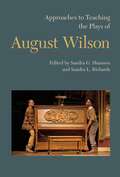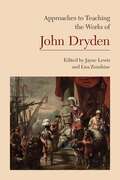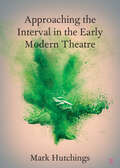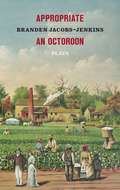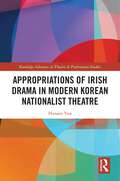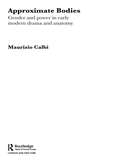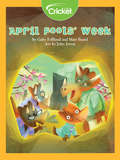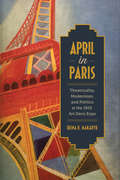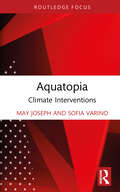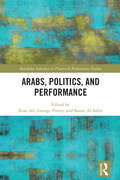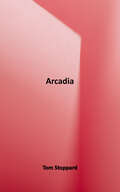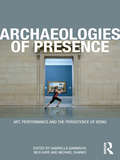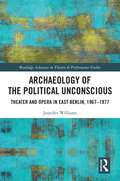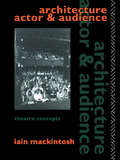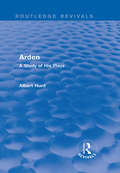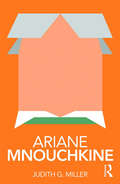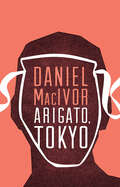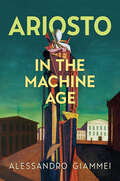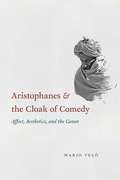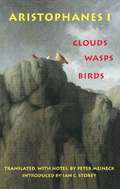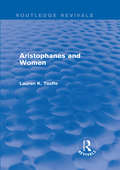- Table View
- List View
Approaches to Teaching Shakespeare's The Taming of the Shrew (Approaches to Teaching World Literature #123)
by Margaret Dupuis and Grace TiffanyThe impetus for this Approaches to Teaching volume on The Taming of the Shrew grew from the editors' desire to discover why a play notorious for its controversial exploration of conflicts between men and women and the challenges of marriage is enduringly popular in the classroom, in the performing arts, and in scholarship. The result is a volume that offers practical advice to teachers on editions and teaching resources in part 1, "Materials," while illuminating how the play's subtle and complex arguments regarding not just marriage but a host of other subjects--modes of early modern education, the uses of clever rhetoric, intergenerational and class politics, the power of theater--are being brought to life in college classrooms. The essays in part 2, "Approaches," are written by English and theater instructors who have taught in a variety of academic settings and cover topics including early modern homilies and music, Hollywood versions of The Taming of the Shrew, and student performances.
Approaches to Teaching the Plays of August Wilson (Approaches to Teaching World Literature #140)
by Sandra G. Shannon and Sandra L. RichardsThe award-winning playwright August Wilson used drama as a medium to write a history of twentieth-century America through the perspectives of its black citizenry. In the plays of his Pittsburgh Cycle, including the Pulitzer Prize-winning Fences and The Piano Lesson, Wilson mixes African spirituality with the realism of the American theater and puts African American storytelling and performance practices in dialogue with canonical writers like Aristotle and Shakespeare. As they portray black Americans living through migration, industrialization, and war, Wilson's plays explore the relation between a unified black consciousness and America's collective identity.In part 1 of this volume, "Materials," the editors survey sources on Wilson's biography, teachable texts of Wilson's plays, useful secondary readings, and compelling audiovisual and Web resources. The essays in part 2, "Approaches," look at a diverse set of issues in Wilson's work, including the importance of blues and jazz, intertextual connections to other playwrights, race in performance, Yoruban spirituality, and the role of women in the plays.
Approaches to Teaching the Works of John Dryden (Approaches to Teaching World Literature #126)
by The Modern Language AssociationWhich John Dryden should be brought into the twenty-first-century college classroom? The rehabilitator of the ancients? The first of the moderns? The ambivalent laureate? The sidelined convert to Rome? The literary theorist? The translator? The playwright? The poet? This volume in the MLA series Approaches to Teaching World Literature addresses the tensions, contradictions, and versatility of a writer who, in the words of Samuel Johnson, "found [English poetry] brick, and left it marble," who was, in the words of Walter Scott, "one of the greatest of our masters."Part 1, "Materials," offers a guide to the teaching editions of Dryden's work and a discussion of the background resources, from biographies and literary criticism to social, cultural, political, and art histories. In part 2, "Approaches," essays describe different pedagogical entries into Dryden and his time. These approaches cover subjects as various as genre, adaptation, literary rivalry, musical setting, and political and religious poetry in classroom situations that range from the traditional survey to learning through performance.
Approaching the Interval in the Early Modern Theatre: The Significance of the 'Act-Time' (Elements in Shakespeare Performance)
by Mark HutchingsIn requiring artificial light, the early modern indoor theatre had to interrupt the action so that the candles could be attended to, if necessary. The origin of the five-act, four-interval play was not classical drama but candle technology. This Element explores the implications of this aspect of playmaking. Drawing on evidence in surviving texts it explores how the interval affected composition and stagecraft, how it provided opportunities for stage-sitters, and how amphitheatre plays were converted for indoor performance (and vice versa). Recovering the interval yields new insights into familiar texts and brings into the foreground interesting examples of how the interval functioned in lesser-known plays. This Element concludes with a discussion of how this aspect of theatre might feed into the debate over the King's Men's repertory management in its Globe-Blackfriars years and sets out the wider implications for both the modern theatre and the academy.
Appropriate/An Octoroon: Plays
by Branden Jacobs-Jenkins<p>A double-volume containing two astonishing breakout plays from one of the theatre's most exciting and provocative young writers. <p>In Appropriate, strained familial dynamics collide with a tense undercurrent of socio-political realities when the Lafayettes gather at a former plantation home to sift through the belongings of their deceased patriarch. An Octoroon is an audacious investigation of theatre and identity, wherein an old play gives way to a startlingly original piece. <p>Also includes the short play I Promise Never Again to Write Plays About Asians...</p>
Appropriations of Irish Drama in Modern Korean Nationalist Theatre (Routledge Advances in Theatre & Performance Studies)
by Hunam YunThis book investigates the translation field as a hybrid space for the competing claims between the colonisers and the colonised. By tracing the process of the importation and appropriation of Irish drama in colonial Korea, this study shows how the intervention of the competing agents – both the colonisers and the colonised – formulates the strategies of representation or empowerment in the rival claims of the translation field. This exploration will be of great interest to students and scholars of theatre and performance studies, translation studies, and Asian studies.
Approximate Bodies: Gender and Power in Early Modern Drama and Anatomy
by Maurizio CalbiThe early modern period was an age of anatomical exploration and revelation, with new discoveries capturing the imagination not only of scientists but also of playwrights and poets. Approximate Bodies examines, in fascinating detail, the changing representation of the body in early modern drama and in the period's anatomical and gynaecological treatises. Maurizio Calbi focuses on the unstable representation of both masculinity and femininity in Renaissance texts such as The Duchess of Malfi, The Changeling and a variety of Shakespeare plays. Drawing on theorists including Foucault, Derrida and Lacan, these close textual readings examine the effects of social, psychic and cultural influences on early modern images of the body. Calbi identifies the ways in which political, social, racial and sexual power structures effect the construction of the body in dramatic and anatomical texts. Calbi's analysis displays how images such as the deformed body of the outsider, the effeminate body of the desiring male and the disfigured body parts of the desiring female indicate an unstable, incomplete conception of the body in the Renaissance. Compelling and impeccably researched, this is a sophisticated account of the fantasies and anxieties that play a role in constructing the early modern body. Approximate Bodies makes a major contribution to the field of early modern studies and to debates around the body.
April Fools' Week
by Gaby FeBlandMeet the many generations of the great Dinostein Pranksters! In this family, April Fools' lasts a whole week. It's a tradition that dates back to the Jurassic Period. But little Joelle maybe the best prankster yet!
April in Paris: Theatricality, Modernism, and Politics at the 1925 Art Deco Expo
by Irena MakarykAttracting over fifteen million visitors, the 1925 Paris Expo had an ambitious goal to create a new modernist style which would reflect the great scientific, industrial, and technological advances that produced a new spirit known as "modern." In April in Paris, author Irena R. Makaryk explores the theatre arts’ vital cultural and political impact at this celebrated international exhibition. Drawing extensively from unexplored archival documents from France, Austria, and North America, April in Paris is the first major study to focus on theatre arts at the 1925 Paris Expo and the audacious Soviet contributions to this fair. Turning a spotlight on the uses and representations of theatricalized spaces, Makaryk analyses their political challenge at a time when relations between the West and the USSR were rife with tension. Copiously illustrated with beautiful colour and black and white illustrations, this book elucidates the complex role of the international fair as a catalyst for spirited cultural debate and for aesthetic change.
Aquatopia: Climate Interventions (Critical Climate Studies)
by May Joseph Sofia VarinoAquatopia documents Harmattan Theater’s ecological interventions and traces its engagements with water-bound landscapes, colonial histories, climate change, and public space across New York City, Venice, Amsterdam, Lisbon, and Cochin. The volume uses Harmattan’s site-specific performances as a point of departure to consider climate change and rising sea levels as geographical, ecological, and urban phenomena. Instead of a collection of flat, static surfaces, the Aquatopia atlas is animated by a disorienting, anti-mapping strategy, producing a deterritorialized, nomadic, fluid atlas unfolding in real time as an archive of climate change in multidimensional, active space. The book is designed for pedagogical access, with interludes that consolidate the learning outcomes of the experimental theory animating each site-specific performance. Accompanied by close descriptions of five performances and supplemented by digital documentation available online, this volume intervenes in discussions on climate change, urbanism, and postcolonization/decolonialization, and contributes to interdisciplinary studies of ecology and environmental politics, postcolonial/decolonial theories and practices, performance studies and aesthetics, in particular public art, and performance as research.
Arabs, Politics, and Performance (ISSN)
by Samer Al-Saber Roaa Ali George PotterThis book is a ground-breaking collection on contemporary Arab theatre.Through three sections discussing occupation and resistance, diaspora, migration, and refugees, and nationalism and belonging, this study provides nuanced responses to the contested points of intersection between Arab culture and the West, as well as many of the major concerns within contemporary Arab theatre. The collection draws together scholars from the Middle East, North Africa, Europe, and the United States who write about Arab theatre and the representation of Arabs on European and American stages. It introduces concerns in contemporary Arab theatre, the regions in which Arab theatre is performed, and the issues with representations of Arabs onstage.This volume will be of great significance for those interested in expanding the range of global, postcolonial, African, Asian, or diasporic theatre that they study, teach, or stage.
Arcadia: A Play
by Tom StoppardThis play takes readers back and forth between the 19th and 20th centuries. Set in a large country house in Derbyshire, a cast of characters from each century play out their respective dramas.
Archaeologies of Presence
by Michael Shanks Gabriella Giannachi Nick KayeArchaeologies of Presence is a brilliant exploration of how the performance of presence can be understood through the relationships between performance theory and archaeological thinking. Drawing together carefully commissioned contributions by leading international scholars and artists, this radical new work poses a number of essential questions: What are the principle signifiers of theatrical presence? How is presence achieved through theatrical performance? What makes a memory come alive and live again? How is presence connected with identity? Is presence synonymous with 'being in the moment'? What is the nature of the ‘co-presence’ of audience and performer? Where does performance practice end and its documentation begin? Co-edited by performance specialists Gabriella Giannachi and Nick Kaye, and archaeologist Michael Shanks, Archaeologies of Presence represents an innovative and rewarding feat of interdisciplinary scholarship.
Archaeology of the Political Unconscious: Theater and Opera in East Berlin, 1967–1977 (ISSN)
by Jennifer WilliamsThis book investigates the aesthetic and political dialectics of East Berlin to argue how its theater and opera stages incited artists to act out, fuel, and resist the troubled construction of political legitimacy.This volume investigates three case studies of how leading East Berlin stages excavated fragmentary materials from Weimar dramatist Bertolt Brecht’s oeuvre and repurposed them for their post‑fascist society: Uta Birnbaum’s 1967 Man Equals Man at the Berliner Ensemble, Joachim Herz’s 1977 Rise and Fall of the City of Mahagonny at the Komische Oper, and Heiner Muller’s own productions of his trailblazing plays. In each instance, reused theatrical artifacts dialectically expressed the contradictions inherent in East German political legitimacy, at once amplifying and critiquing it. Illuminated by original archival research and translations of letters and artistic ephemera published in English for the first time, and engaging with alternative East German feminist epistemologies, this book’s critical investigation of culture and political legitimacy in the shadow of Germany’s fascist past resonates beyond the Iron Curtain into the twenty‑first century. Its final chapter examines how performative artifacts influence the process of political legitimation in more recent history, ranging from Checkpoint Charlie tourism to the January 6, 2021 US insurrection.This study will be of great interest to students and scholars in theater and performance studies, art history, musicology, German studies, anthropology, and political science.
Architecture, Actor and Audience (Theatre Concepts)
by Iain MackintoshUnderstanding the theatre space on both the practical and theoretical level is becoming increasingly important to people working in drama, in whatever capacity. Theatre architecture is one of the most vital ingredients of the theatrical experience and one of the least discussed or understood. In Architecture, Actor and Audience Mackintosh explores the contribution the design of a theatre can make to the theatrical experience, and examines the failings of many modern theatres which despite vigorous defence from the architectural establishment remain unpopular with both audiences and theatre people. A fascinating and provocative book.
Arden: A Study of His Plays (Routledge Revivals)
by Albert HuntJohn Arden was one of the major playwrights to have emerged during the 1950s, yet his work has arguably been misunderstood. In this book, first published in 1974, Albert Hunt’s primary concern is to relate the plays written by John Arden alone, as well as those written in collaboration with Margaretta D’Arcy, both to Arden’s whole concept of theatre, and to his social and political attitudes. The book begins with a biographical introduction, followed by a play-by-play study of Arden’s work and a survey of the impact of his plays in performance, alongside fascinating images. Celebrating the work and life of the playwright, this timely reissue will be of particular value to students of theatre studies as well as professional actors with an interest in John Arden’s plays and theatrical ideologies.
Are We Pears Yet?
by Miranda PaulTwo seeds can't wait to be pears, but growing takes time and patience in this funny and informative picture book from Miranda Paul, the author of Water is Water."When will we be pears?" —"After we find soil." "Hooray! We are going to be pears! Are we pears yet?" —"No! Just be patient and wait."Written entirely in dialogue and staged as a play, Are We Pears Yet? is a clever and hilarious informational picture book that will make you look at growth cycles and fruit trees in a whole new way. Carin Berger's artfully composed collaged stage sets will delight and amaze you.
Ariane Mnouchkine (Routledge Performance Practitioners)
by Judith MillerOver the last forty years, French director Ariane Mnouchkine and her theater collective, Le Théâtre du Soleil, have devised a form of research and creation that is both engaged with contemporary history and committed to reinvigorating theater by focusing on the actor. Now revised and reissued, this volume combines: ● an overview of Mnouchkine’s life, work and theatrical influences ● an exploration of her key ideas on theater and the creative process ● analysis of key productions, including her early and groundbreaking environmental political piece, 1789, and the later Asian-inspired play penned by Hélène Cixous, Drums on the Dam. ● practical exercises, including tips on mask work. As a first step toward critical understanding, and as an initial exploration before going on to further, primary research, Routledge Performance Practitioners offer unbeatable value for today’s student.
Arigato, Tokyo
by Daniel MacIvorOn a publicity tour in Japan, Carl, a Canadian author, finds himself falling in love amidst the sacred stages of Noh theatre and the seedy dance clubs in Tokyo, wired on cocaine and sake. His object of affection is the young, seductive actor, Yori, but the affair becomes complicated when Carl’s translator and Yori’s sister, Nushi, becomes entranced with him. As his tour continues, he straddles the fragmentary place between two cultures—one of individuality and directness, the other of tradition and formality—and uncovers the dualities that exist in life and love. Based on The Tale of Genji, one of the world’s oldest pieces of literature, MacIvor’s script takes us into the centre of a clandestine Japan as experienced by the visiting outsider.
Ariosto in the Machine Age (Toronto Italian Studies)
by Alessandro GiammeiAriosto in the Machine Age reveals how the most influential poet of the Renaissance was conjured or appropriated to shape Magical Realism, avant-garde painting, Fascist cultural propaganda, and cinema in modern Italy between the birth of Futurism and the end of the Second World War. Based on substantial archival findings, bold iconographic hypotheses, and novel interpretations of literary texts, the book proposes a new account of Italy’s twentieth-century culture through a unique take on Ludovico Ariosto’s early modern poetics and legacy. Starting from the unexpected passéism of Futurists visiting Ferrara on the eve of the First World War, it rereads the development of Giorgio de Chirico’s Metaphysical art and Massimo Bontempelli’s Realismo Magico. The book reconstructs the multimedia archive of the Fascist initiatives for the 1933 centennial anniversary of Ariosto’s death, and then focuses on the passage between Fascist cinema and the birth of neorealism, unearthing unfinished adaptations of the Orlando Furioso by Luchino Visconti and Alessandro Blasetti. Questioning the very concept of reception, this radically interdisciplinary book warns twenty-first-century readers about the risks of monumentalizing the "great authors" of the past.
Ariosto, Shakespeare and Corneille (Collected Works)
by Benedetto CroceOriginally published in 1921 this volume consists of the first of Croce’s literary criticisms to be published in English and as well as a section on Shakespeare, it contains unique essays on Ariosto and Corneille which together inaugurated a new era in literary criticism. The essays are based on Croce’s Theory of Aesthetic - a theory which to many is the only one that completely explains the problem of poetry and the fine arts - and as a result are profound and suggestive.
Aristophanes & the Cloak of Comedy: Affect, Aesthetics, and the Canon
by Mario TelòThe Greek playwright Aristophanes (active 427–386 BCE) is often portrayed as the poet who brought stability, discipline, and sophistication to the rowdy theatrical genre of Old Comedy. In this groundbreaking book, situated within the affective turn in the humanities, Mario Telò explores a vital yet understudied question: how did this view of Aristophanes arise, and why did his popularity eventually eclipse that of his rivals? Telò boldly traces Aristophanes’s rise, ironically, to the defeat of his play Clouds at the Great Dionysia of 423 BCE. Close readings of his revised Clouds and other works, such as Wasps, uncover references to the earlier Clouds, presented by Aristophanes as his failed attempt to heal the audience, who are reflected in the plays as a kind of dysfunctional father. In this proto-canonical narrative of failure, grounded in the distinctive feelings of different comic modes, Aristophanic comedy becomes cast as a prestigious object, a soft, protective cloak meant to shield viewers from the debilitating effects of competitors’ comedies and restore a sense of paternal responsibility and authority. Associations between afflicted fathers and healing sons, between audience and poet, are shown to be at the center of the discourse that has shaped Aristophanes’s canonical dominance ever since.
Aristophanes 1: Clouds, Wasps, Birds
by Aristophanes Ian C. Storey Peter MeineckOriginally adapted for the stage, Peter Meineck's revised translations achieve a level of fidelity appropriate for classroom use while managing to preserve the wit and energy that led The New Yorker to judge his CloudsThe best Greek drama we've ever seen anywhere," and The Times Literary Supplement to describe his Wasps as "Hugely enjoyable and very, very funny. A general Introduction, introductions to the plays, and detailed notes on staging, history, religious practice and myth combine to make this a remarkably useful teaching text.
Aristophanes and Women (Routledge Revivals)
by Lauren TaaffeAristophanes and Women, first published in 1993, investigates the workings of the great Athenian comedian’s ‘women plays’ in an attempt to discern why they were in fact probably quite funny to their original audiences. It is argued that modern students, scholars, and dramatists need to consider much more closely the conditions of the plays’ ancient productions when evaluating their ostensible themes. Three plays are focused upon: Lysistrata, Thesmophoriazusae, and Ecclesiazusae. All seem to speak quite eloquently to contemporary concerns about women’s rights, the value of women’s work, and the relationships between women and war, literary representation and politics. On the one hand, Professor Taaffe tries to retrieve what an ancient Athenian audience may have l appreciated about these plays and what their central theses may have meant within that culture. On the other hand, Aristophanes is discussed from the perspective of a late twentieth-century, specifically female, reader.
Aristophanes and the Poetics of Competition
by Zachary P. BilesAthenian comic drama was written for performance at festivals honouring the god Dionysos. Through dramatic action and open discourse, poets sought to engage their rivals and impress the audience, all in an effort to obtain victory in the competitions. This book uses that competitive performance context as an interpretive framework within which to understand the thematic interests shaping the plots and poetic quality of Aristophanes' plays in particular, and of Old Comedy in general. Studying five individual plays from the Aristophanic corpus as well as fragments of other comic poets, it reveals the competitive poetics distinctive to each. It also traces thematic connections with other poetic traditions, especially epic, lyric, and tragedy, and thereby seeks to place competitive poetics within broader trends in Greek literature.

